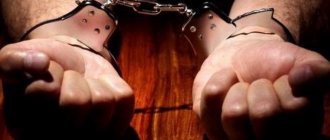Human life is priceless, and its deprivation is punishable by law with long terms. If the victim experienced physical, moral and psychological suffering before death, then such deprivation of life is aggravated by special cruelty and refers to Art. 105, part 2., as well as the murder of the victim in front of his loved ones. In a murder with particular cruelty, the criminal not only has the intent to kill himself, but also deliberately makes the victim suffer through torture, bullying and violence. The object of the murder, in addition to the victim herself, is her physical and moral condition, and the subject is the accused who has reached the age of 14 years.
Classification
Article 105 of the Criminal Code of the Russian Federation itself does not contain a list of actions that are considered especially cruel, and this is explained by the resolution of the Plenum of the Supreme Court:
- the person was tortured during the killing process or immediately before death;
- when committing the murder, a method was used that caused suffering to the victim - drowning, burial alive, inflicting multiple wounds and many others;
- murder in front of family and friends is also equated with special cruelty;
- the offender prolongs the victim’s suffering and does not provide assistance.
The killer must understand that the victim suffers from his actions.
The heat of passion
It is necessary to understand that with a high degree of probability, in order to significantly reduce the severity of responsibility, Ivanov’s lawyer would insist that the crime was committed in a state of passion, since the criminal experienced serious moral trials in the form of his wife’s betrayal. It is this moment, unfortunately, that sometimes “saves” murderers from fair punishment.
But sometimes it helps to avoid maximum punishment for those who really could not be held accountable for their actions.
It’s the same situation from the example, but Alekseev’s wife, before whose eyes a brutal murder was committed, realizing that she would be the next victim, fell into hysterics and somehow freed herself from her bonds. Having picked up the first thing that came to hand (a hammer), she attacked Ivanov and struck him more than 50 blows to the head and chest.
The previously announced difference in the severity of punishment according to Article 107 of the Criminal Code of the Russian Federation is as follows:
- Murder committed in a state of sudden strong emotional disturbance (affect) caused by violence, mockery or grave insult on the part of the victim or other illegal or immoral actions (inaction) of the victim, as well as a long-term psychologically traumatic situation that arose in connection with systematic illegal or immoral behavior victim, is punishable by correctional labor for a term of up to two years, or restriction of freedom for a term of up to three years, or forced labor for a term of up to three years, or imprisonment for the same term.
- The murder of two or more persons, committed in a state of passion, is punishable by forced labor for up to five years or imprisonment for the same period.
As you can see, the maximum punishment under this article, taking into account the fact that more than 1 person was killed, is only 5 years in prison. Therefore, it is very important to determine the real motive and state of the criminal.
What is the punishment for murder committed with extreme cruelty?
Murder committed with particular cruelty is punishable only by real terms. This can be imprisonment for a term of 8 to 20 years with restriction of freedom from one to two years, life imprisonment or the death penalty. Moreover, a murder cannot be classified as particularly cruel if the victim did not feel anything at the time of the abuse, since she was dead. Various actions with a corpse (mockery, dismemberment, sexual acts, etc.) do not constitute murder committed with particular cruelty.
What to do if you are accused of murder with extreme cruelty?
We have much more opportunities, knowledge and practice than people who do not constantly face criminal practice. Even if you are guilty, we will help mitigate the punishment and get out of this situation with minimal losses, up to a suspended sentence, for which there are real examples from practice. At the investigation stage, the chances of a positive outcome are much greater, so call us or leave a request as early as possible!
| Providing defense in criminal cases: | Price |
| Visiting detainees in pre-trial detention centers (places of deprivation of liberty) for the purpose of giving legal advice: | from 20,000 rub. |
| Participation of a defense attorney in a court hearing under Art. 125 Code of Criminal Procedure of the Russian Federation: | from 30,000 rub. |
| Participation of a defense lawyer in a court hearing when choosing a preventive measure, extension of the period of detention: | from 30,000 rub. |
| Protection of the client during the investigation, preliminary investigation before sending the criminal case to court | from 50,000 rub. |
| Defense of the principal in the court of first instance, if the defense attorney participated in the preliminary investigation: | from 30,000 rub. |
| Defense of the client in the court of first instance, if the defense attorney did not participate in the preliminary investigation: | from 50,000 rub. |
| Appealing the verdict, ruling, decision of the court of first instance to the appellate instance: | from 70,000 rub. |
| Appeal and protest of a court verdict, rulings and decisions in the cassation instance: | from 50,000 rub. |
| Protection of the principal in court by way of supervision | from 30,000 rub. |
| Organization of examinations, consultations with the participation of specialists, experts in various fields of activity | from 15,000 rub. |
The objective side of murder.
The objective side of murder is the violent deprivation of the life of another person. All types of murders are expressed in the deprivation of the victim’s life (material composition).
Consideration of the objective side of murder should begin with identifying the signs that characterize it. Since the corpus delicti provided for in Art. 105 of the Criminal Code, is material in its design, then the objective side will be characterized by three mandatory features:
socially dangerous act;
· socially dangerous consequence;
· a causal relationship between a socially dangerous act and a socially dangerous consequence.
The first sign of the objective side of a crime is a socially dangerous act, which can be expressed both in the form of action and in the form of inaction.
Action is an active form of criminal human behavior, which is expressed in mechanical movements that cause changes in the external world. Most often, murder is committed precisely through an action aimed at disrupting the functions or anatomical integrity of the vital organs of another person.
A person's action can not only directly and immediately cause the death of another person, but it can also set in motion some other forces that subsequently cause the death of another person. We can divide all possible options for a person’s actions during a murder into several types, differing in the form of impact on the life of the victim.
Murder can be committed by such actions when the criminal, without resorting to the use of any means or instruments, causes the death of the victim using only the muscular strength of his body (for example, strangulation by the throat with his hands).
The actions of the perpetrator can be carried out by using his muscular strength, but with the use of certain tools to enhance this force and facilitate the murder (for example, hitting the victim with a knife).
Further, the actions of the perpetrator may be expressed in directing some other forces towards the victim. The muscular force may be negligible, but it can direct another powerful force that causes death (such as homicide with a firearm). In such cases, a person's muscular strength gives impetus to another force, which causes the death of the victim.
Finally, actions during murder can take the form of mental activity and be very diverse.
First of all, this is a direct mental impact on the victim, which can cause painful disorders and death, mainly in persons with heart disease and vascular disease. In addition, severe fright can also cause cardiac arrest and death. In such cases, neither the muscular strength of the perpetrator nor the muscular strength of another person is used.
Mental influence should also include conspiracy to commit the murder of another minor, or a person unable to understand the nature of his actions and control them. Such cases are called mediocre infliction, entailing liability for the subject who conceived and carried out the crime in a similar way.
Intentional murders can be committed not only through action, but also through inaction. Criminal inaction is a form of passive behavior and is distinguished by the fact that a person refrains from all movements, and his strength is in a state of physical rest. Consequently, inaction during a murder should be understood as the volitional, conscious abstinence of the perpetrator from committing certain acts, that is, non-interference in the development of events that take place outside the activities of the perpetrator, the result of which was the desired or permitted death. In case of inaction, it is inevitably necessary to establish under what circumstances a certain person was obliged to act, and whether he could have performed these actions. At the same time, the obligation to act in a certain way may stem not only from the requirements of laws and regulations, but also from “naturally developing relationships between people.” N.I. Zagorodnikov writes that “there is no special law obliging a mother to feed her child, but when a mother kills a newborn child through inaction (depriving the baby of food), there is no doubt as to whether she is liable for this inaction”[9].
In addition, according to E.F. Pogaylo, the obligation to act can stem from a contract, as well as from “the previous activities of the perpetrator - the so-called implied facts (when the person who put someone in danger is obliged to take the necessary measures to save)”[10]. For example, the culprit, knowing that the victim was a poor swimmer, persuaded him to swim a long distance, promising help if necessary. However, he did not provide assistance at the right moment, wanting the victim to drown. This example given by E.F. Ran around, needs clarification. Murder here will only occur if the perpetrator deliberately provoked the victim to such actions and hoped to achieve his death in this way. But it is extremely difficult, if not impossible, to prove this fact. In all other cases, the actions of the perpetrator will contain signs of a crime under Art. 125 of the Criminal Code of the Russian Federation (Leaving in danger).
The assessment of the ability of the accused to act in a certain way is based on a subjective criterion: could this person, taking into account his knowledge and qualifications, experience, state of health, in this particular situation, perform the action that was required of him, if he had shown the maximum activity available to him.
As already indicated above, the corpus delicti provided for in Art. 105 of the Criminal Code is material in design, therefore a mandatory sign of the objective side of a crime is the onset of a socially dangerous consequence. A criminal consequence is one or another harm caused by a criminal act or inaction to the object of the attack. In this case, such a consequence will be the death of the victim.
Finally, another sign of the objective side of murder is the causal connection between the act of the perpetrator and the death of the victim.
The science of criminal law has not created a special concept of causality, independent of the philosophical category of causality. Therefore, the theory of criminal law places the principles developed by philosophy as the basis for solving the issue of causation. Causality is defined by philosophy as an objective, that is, a connection existing independently of human consciousness between the generating (cause) and the generated (effect) phenomenon. The specificity of this definition in the criminal legal sphere is that only a socially dangerous act is considered as a cause, and only a socially dangerous result as a consequence. It is possible to recognize the existence of a causal relationship only in the case when the act of the perpetrator inevitably entails the death of a person and is its main cause. Moreover, for the corpus delicti it is absolutely irrelevant how soon after the perpetrator committed the relevant act the death of the victim occurred. Murder will occur both when death followed immediately after the perpetrator committed a criminal act (for example, after a shot in the head), and when it occurred after a significant period of time (for example, poisoning with a delayed-action poison).
A necessary prerequisite for correctly resolving the issue of causation is a known sequence of human actions and the occurrence of a criminal result. Only the act that preceded in time the onset of the harmful result can be in a causal connection with the harmful consequence that has occurred. Naturally, an act committed after the occurrence of a particular fact cannot determine or be the cause of these consequences.
The theory of criminal law also includes such characteristics as the time, place, setting and method of committing the crime to characterize the objective side of the crime. Of all the above features, the main significance for qualifying the offense under Art. 105 of the Criminal Code establishes the method of action as a sign of the objective side. Establishing special cruelty when killing or committing it in a way dangerous to the lives of many people entails qualification according to paragraphs. “d” and “e” art. 105 of the Criminal Code and excludes the application of another article of the Code. The remaining signs are not mandatory for qualification, but may be taken into account by the court when assigning punishment.
Practice shows that a large number of criminal attacks on life are not completed and are classified as an attempt or preparation for murder.
Preparation for a crime is determined by Art. 30 of the Criminal Code as the search, manufacture or adaptation by a person of means or instruments for committing a crime, the search for accomplices to a crime, conspiracy to commit a crime or other deliberate creation of conditions for the commission of a crime, if the crime was not completed due to circumstances beyond the control of this person. From this formulation it is clear that the law does not provide an exhaustive list of all specific actions that can be considered as preparation for a crime. Yes, this is impossible to do. The law gives only a general indication of these actions. They can be considered as preparation for a crime only if they are aimed at deliberately creating conditions for the commission of the latter. In relation to murder, such actions are usually expressed in the acquisition or search for murder weapons (for example, firearms or bladed weapons, toxic substances, etc.), in familiarization with the area where the murder is supposed to be committed, in creating conditions for concealing traces of the crime, in the search accomplices to murder, etc. In practice, these actions are very difficult to detect, and it is also very difficult to prove that this or that action is preparation for a crime (for example, buying an ax in a store). But in all possible cases without exception, preparatory actions for murder should entail criminal liability under the article of the Criminal Code on murder.
Attempted crime, in accordance with Art. 30 of the Criminal Code, an intentional act directly aimed at committing a crime is recognized if the crime was not completed for reasons beyond the will of the perpetrator.
An attempt differs from preparation in that in it the subject commits actions directly aimed at committing a crime, that is, he carries out a direct attack on the object. So, for example, if the acquisition of a firearm for the purpose of committing murder should be considered as preparation for a crime, then aiming this weapon at a victim, and even more so shooting at her, if the fatal result did not occur, is an attempt.
Attempted murder should be distinguished from other completed crimes against the person. In practice, serious difficulties arise when distinguishing such an attempt from intentional bodily harm. Actions aimed at taking a life, if death was avoided, cannot be qualified as intentional infliction of bodily harm. The difficulty of such a distinction stems from the fact that in an attempted murder, only bodily harm is often inflicted on the person.
The main criterion for distinguishing these crimes is the direction of intent of the perpetrator. If the intent is aimed at taking a life, then the act should be qualified as an attempt, despite the fact that only bodily harm is caused to the victim.
The objective side of murder is the violent deprivation of the life of another person. All types of murders are expressed in the deprivation of the victim’s life (material composition).
Consideration of the objective side of murder should begin with identifying the signs that characterize it. Since the corpus delicti provided for in Art. 105 of the Criminal Code, is material in its design, then the objective side will be characterized by three mandatory features:
socially dangerous act;
· socially dangerous consequence;
· a causal relationship between a socially dangerous act and a socially dangerous consequence.
The first sign of the objective side of a crime is a socially dangerous act, which can be expressed both in the form of action and in the form of inaction.
Action is an active form of criminal human behavior, which is expressed in mechanical movements that cause changes in the external world. Most often, murder is committed precisely through an action aimed at disrupting the functions or anatomical integrity of the vital organs of another person.
A person's action can not only directly and immediately cause the death of another person, but it can also set in motion some other forces that subsequently cause the death of another person. We can divide all possible options for a person’s actions during a murder into several types, differing in the form of impact on the life of the victim.
Murder can be committed by such actions when the criminal, without resorting to the use of any means or instruments, causes the death of the victim using only the muscular strength of his body (for example, strangulation by the throat with his hands).
The actions of the perpetrator can be carried out by using his muscular strength, but with the use of certain tools to enhance this force and facilitate the murder (for example, hitting the victim with a knife).
Further, the actions of the perpetrator may be expressed in directing some other forces towards the victim. The muscular force may be negligible, but it can direct another powerful force that causes death (such as homicide with a firearm). In such cases, a person's muscular strength gives impetus to another force, which causes the death of the victim.
Finally, actions during murder can take the form of mental activity and be very diverse.
First of all, this is a direct mental impact on the victim, which can cause painful disorders and death, mainly in persons with heart disease and vascular disease. In addition, severe fright can also cause cardiac arrest and death. In such cases, neither the muscular strength of the perpetrator nor the muscular strength of another person is used.
Mental influence should also include conspiracy to commit the murder of another minor, or a person unable to understand the nature of his actions and control them. Such cases are called mediocre infliction, entailing liability for the subject who conceived and carried out the crime in a similar way.
Intentional murders can be committed not only through action, but also through inaction. Criminal inaction is a form of passive behavior and is distinguished by the fact that a person refrains from all movements, and his strength is in a state of physical rest. Consequently, inaction during a murder should be understood as the volitional, conscious abstinence of the perpetrator from committing certain acts, that is, non-interference in the development of events that take place outside the activities of the perpetrator, the result of which was the desired or permitted death. In case of inaction, it is inevitably necessary to establish under what circumstances a certain person was obliged to act, and whether he could have performed these actions. At the same time, the obligation to act in a certain way may stem not only from the requirements of laws and regulations, but also from “naturally developing relationships between people.” N.I. Zagorodnikov writes that “there is no special law obliging a mother to feed her child, but when a mother kills a newborn child through inaction (depriving the baby of food), there is no doubt as to whether she is liable for this inaction”[9].
In addition, according to E.F. Pogaylo, the obligation to act can stem from a contract, as well as from “the previous activities of the perpetrator - the so-called implied facts (when the person who put someone in danger is obliged to take the necessary measures to save)”[10]. For example, the culprit, knowing that the victim was a poor swimmer, persuaded him to swim a long distance, promising help if necessary. However, he did not provide assistance at the right moment, wanting the victim to drown. This example given by E.F. Ran around, needs clarification. Murder here will only occur if the perpetrator deliberately provoked the victim to such actions and hoped to achieve his death in this way. But it is extremely difficult, if not impossible, to prove this fact. In all other cases, the actions of the perpetrator will contain signs of a crime under Art. 125 of the Criminal Code of the Russian Federation (Leaving in danger).
The assessment of the ability of the accused to act in a certain way is based on a subjective criterion: could this person, taking into account his knowledge and qualifications, experience, state of health, in this particular situation, perform the action that was required of him, if he had shown the maximum activity available to him.
As already indicated above, the corpus delicti provided for in Art. 105 of the Criminal Code is material in design, therefore a mandatory sign of the objective side of a crime is the onset of a socially dangerous consequence. A criminal consequence is one or another harm caused by a criminal act or inaction to the object of the attack. In this case, such a consequence will be the death of the victim.
Finally, another sign of the objective side of murder is the causal connection between the act of the perpetrator and the death of the victim.
The science of criminal law has not created a special concept of causality, independent of the philosophical category of causality. Therefore, the theory of criminal law places the principles developed by philosophy as the basis for solving the issue of causation. Causality is defined by philosophy as an objective, that is, a connection existing independently of human consciousness between the generating (cause) and the generated (effect) phenomenon. The specificity of this definition in the criminal legal sphere is that only a socially dangerous act is considered as a cause, and only a socially dangerous result as a consequence. It is possible to recognize the existence of a causal relationship only in the case when the act of the perpetrator inevitably entails the death of a person and is its main cause. Moreover, for the corpus delicti it is absolutely irrelevant how soon after the perpetrator committed the relevant act the death of the victim occurred. Murder will occur both when death followed immediately after the perpetrator committed a criminal act (for example, after a shot in the head), and when it occurred after a significant period of time (for example, poisoning with a delayed-action poison).
A necessary prerequisite for correctly resolving the issue of causation is a known sequence of human actions and the occurrence of a criminal result. Only the act that preceded in time the onset of the harmful result can be in a causal connection with the harmful consequence that has occurred. Naturally, an act committed after the occurrence of a particular fact cannot determine or be the cause of these consequences.
The theory of criminal law also includes such characteristics as the time, place, setting and method of committing the crime to characterize the objective side of the crime. Of all the above features, the main significance for qualifying the offense under Art. 105 of the Criminal Code establishes the method of action as a sign of the objective side. Establishing special cruelty when killing or committing it in a way dangerous to the lives of many people entails qualification according to paragraphs. “d” and “e” art. 105 of the Criminal Code and excludes the application of another article of the Code. The remaining signs are not mandatory for qualification, but may be taken into account by the court when assigning punishment.
Practice shows that a large number of criminal attacks on life are not completed and are classified as an attempt or preparation for murder.
Preparation for a crime is determined by Art. 30 of the Criminal Code as the search, manufacture or adaptation by a person of means or instruments for committing a crime, the search for accomplices to a crime, conspiracy to commit a crime or other deliberate creation of conditions for the commission of a crime, if the crime was not completed due to circumstances beyond the control of this person. From this formulation it is clear that the law does not provide an exhaustive list of all specific actions that can be considered as preparation for a crime. Yes, this is impossible to do. The law gives only a general indication of these actions. They can be considered as preparation for a crime only if they are aimed at deliberately creating conditions for the commission of the latter. In relation to murder, such actions are usually expressed in the acquisition or search for murder weapons (for example, firearms or bladed weapons, toxic substances, etc.), in familiarization with the area where the murder is supposed to be committed, in creating conditions for concealing traces of the crime, in the search accomplices to murder, etc. In practice, these actions are very difficult to detect, and it is also very difficult to prove that this or that action is preparation for a crime (for example, buying an ax in a store). But in all possible cases without exception, preparatory actions for murder should entail criminal liability under the article of the Criminal Code on murder.
Attempted crime, in accordance with Art. 30 of the Criminal Code, an intentional act directly aimed at committing a crime is recognized if the crime was not completed for reasons beyond the will of the perpetrator.
An attempt differs from preparation in that in it the subject commits actions directly aimed at committing a crime, that is, he carries out a direct attack on the object. So, for example, if the acquisition of a firearm for the purpose of committing murder should be considered as preparation for a crime, then aiming this weapon at a victim, and even more so shooting at her, if the fatal result did not occur, is an attempt.
Attempted murder should be distinguished from other completed crimes against the person. In practice, serious difficulties arise when distinguishing such an attempt from intentional bodily harm. Actions aimed at taking a life, if death was avoided, cannot be qualified as intentional infliction of bodily harm. The difficulty of such a distinction stems from the fact that in an attempted murder, only bodily harm is often inflicted on the person.
The main criterion for distinguishing these crimes is the direction of intent of the perpetrator. If the intent is aimed at taking a life, then the act should be qualified as an attempt, despite the fact that only bodily harm is caused to the victim.








